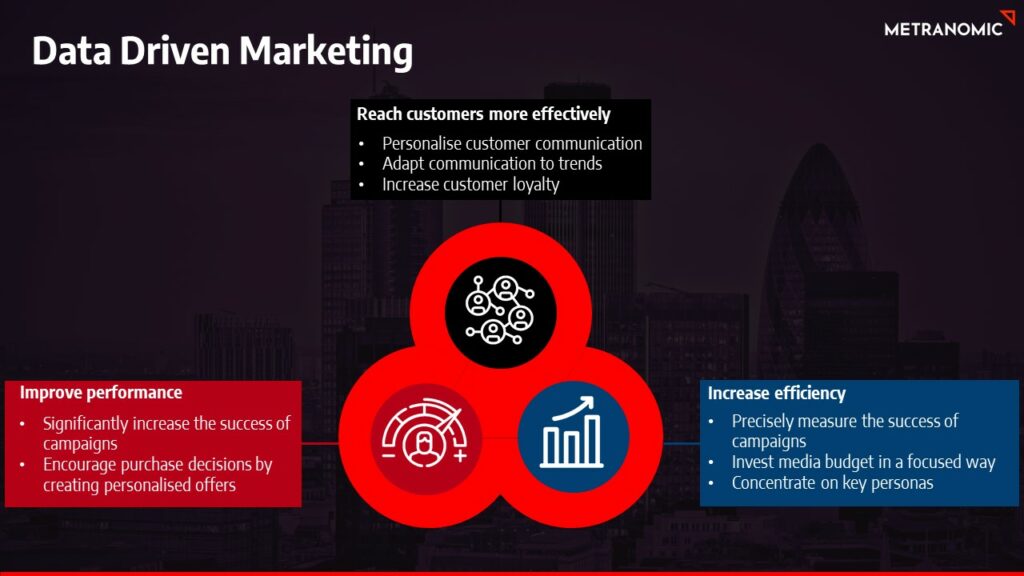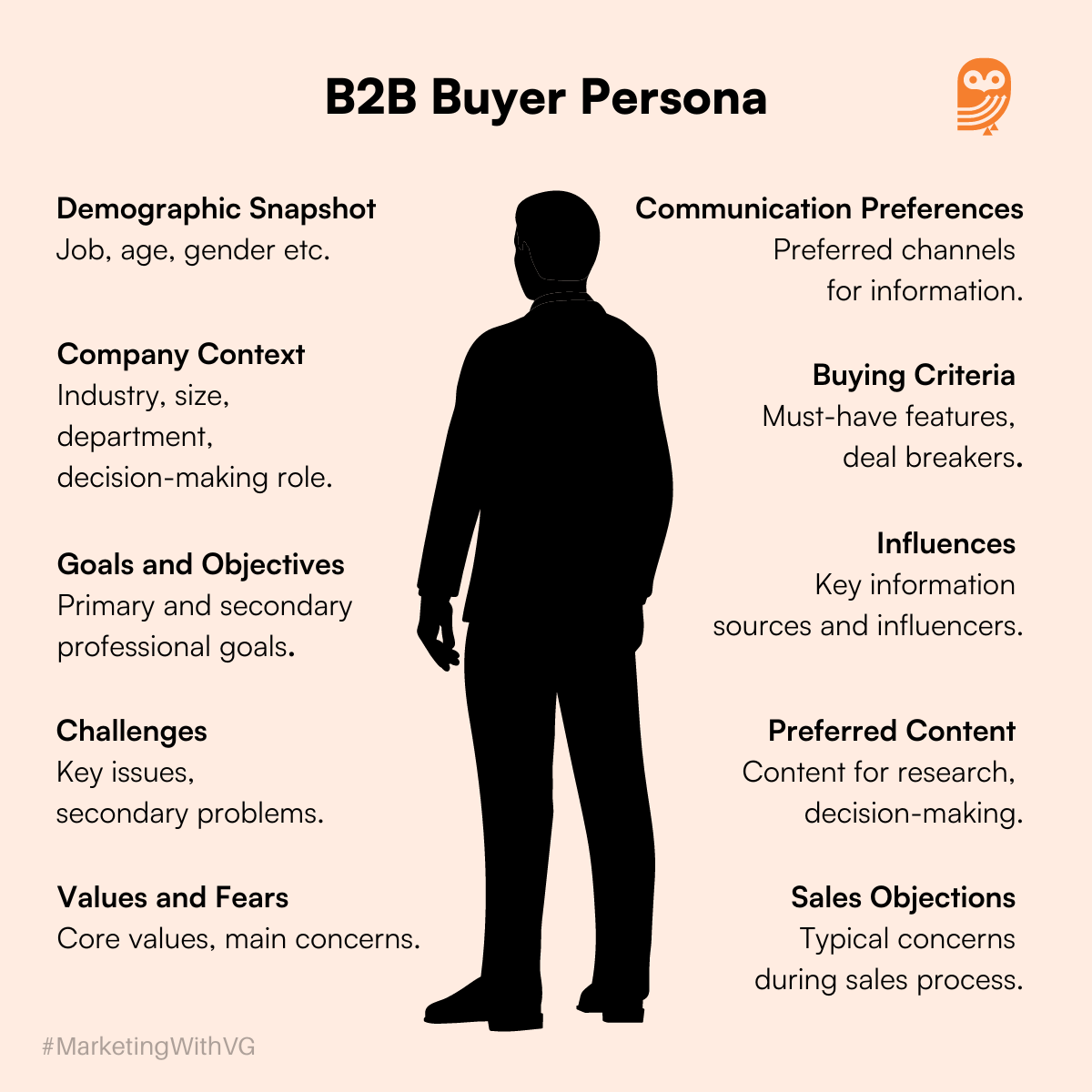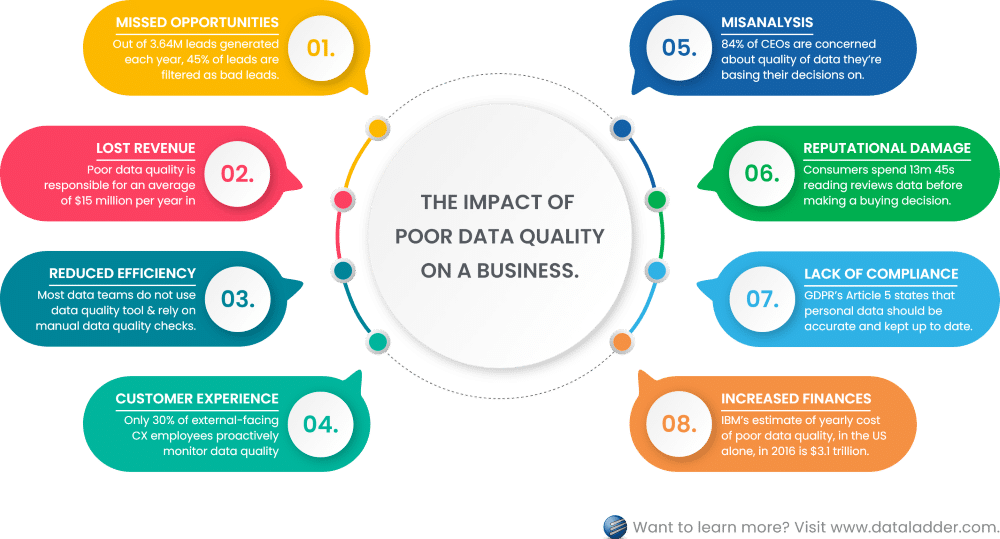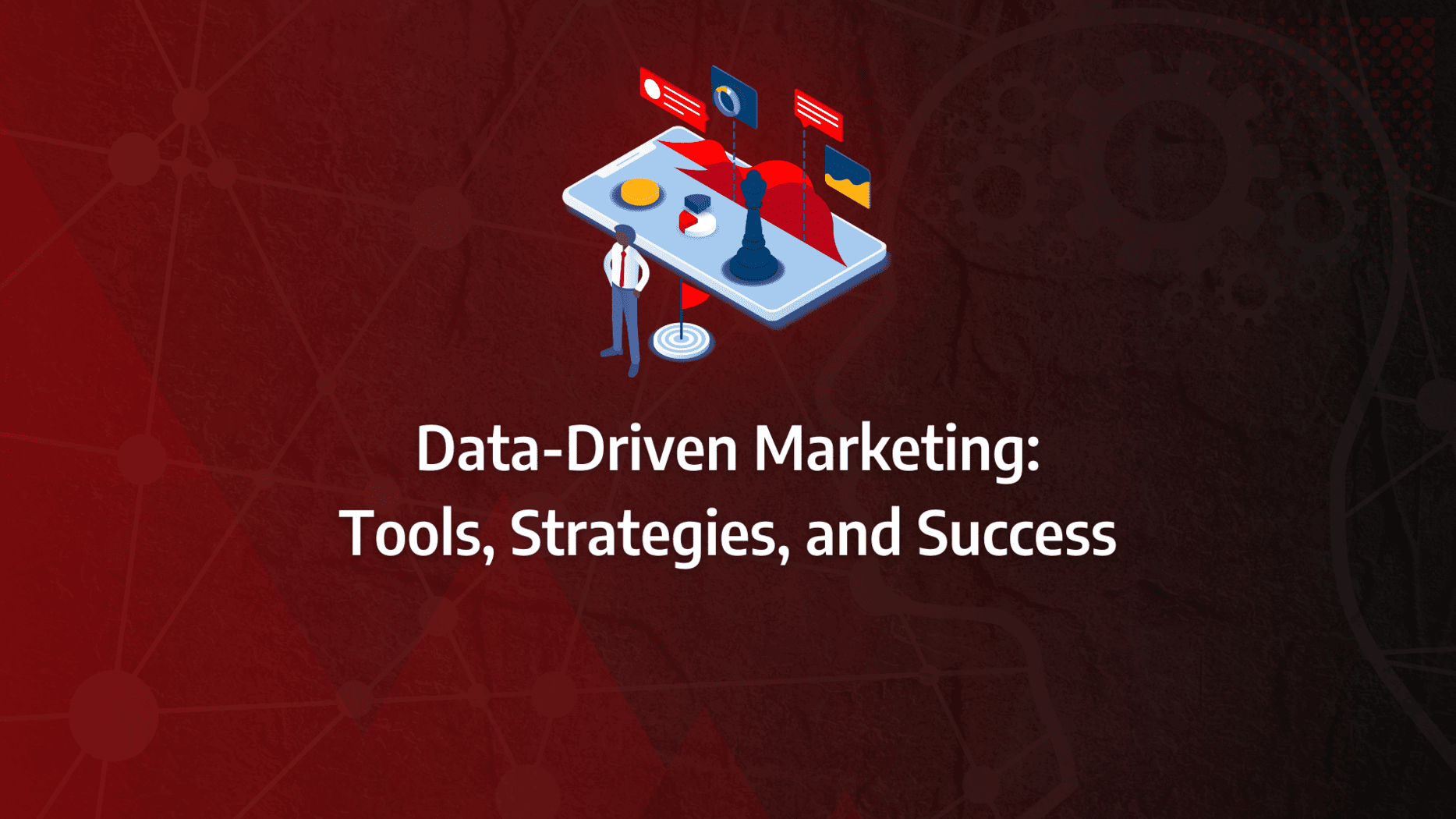Relying on gut feelings or outdated methods can no longer cut it. Data-driven marketing has become the cornerstone of success for businesses that aim to stay ahead. Imagine having the ability to predict customer behaviors, personalise every interaction, and optimise your marketing efforts with precision—this isn’t just a dream, it’s a reality waiting to be unlocked.
But how exactly do you harness this power? In this blog, we delve into the cutting-edge tools and strategies that can transform your marketing approach, helping you turn raw data into actionable insights. You’ll discover how leading businesses are leveraging these techniques to not only meet but exceed their goals.
- Understand the Core of Data-Driven Marketing: Data-driven marketing involves systematically collecting and analysing customer data to create personalised and effective marketing campaigns that resonate with your audience.
- Leverage Predictive Analytics: Use predictive analytics to anticipate customer behaviors and tailor your marketing strategies accordingly, ensuring you stay one step ahead of the competition.
- Choose the Right Tools: Selecting the right data-driven marketing tools, such as CRM systems and marketing automation platforms, is crucial for implementing successful strategies that drive measurable results.
- Build a Robust Data-Driven Strategy: Develop a comprehensive data-driven marketing plan that includes gathering relevant data, creating detailed customer personas, and continuously refining your approach based on analytics.
- Maximize ROI with Data Insights: Use data to optimise marketing spend, improve customer targeting, and enhance overall ROI, ensuring every marketing decision is backed by solid evidence.
- Stay Compliant with Data Regulations: Ensure your data-driven strategies align with privacy laws like GDPR and CCPA, which not only safeguard your operations but also build trust with your customers.
- Embrace Continuous Improvement: Data-driven marketing is an ongoing process; continually evaluate new data and adjust your strategies to adapt to changing market conditions and customer needs.
How to Utilise Database-Driven Marketing
What is Database-Driven Marketing?
Database-driven marketing is the systematic process of collecting and analysing customer data within a company’s database. This method enables companies to better understand and cater to the needs of both existing and potential customers by leveraging historical customer data.
Historically, companies have employed data-driven marketing strategies for many years. However, with the evolution of digital marketing, these strategies have become more sophisticated and integral to business operations. By recording routine sales activities in a database, businesses can develop more effective data-driven marketing strategies that enhance their marketing efforts for products and services.

What are the main advantages of using a database for marketing?
The advantages realised by B2B businesses adopting data-driven marketing tools are substantial. However, transforming the decision-making process for marketing activities can encounter resistance. Patience and clear demonstrations of the benefits are crucial. Here are several benefits:
Identifying Your Total Addressable Market
Data-driven marketing tools allow you to determine the size of your market accurately. For instance, a company like Sopro can build a comprehensive B2B database that maps your entire market by asking a few targeted questions, thus providing detailed market segmentation.
Improving Your Targeting
Creating a market map helps focus your marketing efforts on ideal targets. With data-driven marketing tools, you can refine this process further:
- Develop Ideal Customer Profiles using existing data to target specific companies.
- Construct B2B buyer personas to understand the key decision-makers within those companies.
Enhancing Lead Quality
Segmenting your market and developing detailed profiles allows you to concentrate on the most valuable leads. Lead scoring, a feature of many data-driven marketing tools, further refines lead quality by prioritising leads in your sales pipeline, ensuring your sales team focuses on the most promising prospects.
Crafting Compelling Content
Your buyer personas are invaluable for creating content that resonates with your audience. By analysing customer data, you can understand what drives purchases and tailor your content accordingly. Additionally, examining your website analytics post-publication provides insights into which content performs well and engages your audience.

Improving Every Campaign
Benchmarking against historical campaign data helps ensure continuous improvement. Publishing anonymised campaign results, as Sopro does, offers transparency and sets performance benchmarks. This approach motivates internal teams to surpass these benchmarks, driving better outcomes.
Implementing Personalised Marketing
A staggering 98% of marketers agree that personalisation enhances customer relationships. Data-driven marketing tools enable effective personalisation through:
- Segmented email campaigns and data-driven content insertion.
- Personalised landing pages using platforms like HubSpot.
- Multi-touchpoint campaigns incorporating PPC, display ads, and social media remarketing.
Spotting Blockages in Your Pipeline
Data-driven marketing doesn’t stop at lead generation. Analysing your sales velocity can identify pipeline blockages, thereby improving conversion rates and reducing the time to close deals.
What Matters Most?
Focusing on actionable insights rather than just collecting data profoundly enhances decision-making effectiveness. Clients often discover that integrating various data sources provides a comprehensive view of customer behaviour, enabling them to craft targeted strategies that truly resonate. Additionally, understanding customer journeys through thorough data analysis typically leads to the creation of personalised content, which significantly boosts engagement and satisfaction levels across the board.Get In Touch
Practical Examples of Data-Driven Marketing Strategies
Data-Driven Marketing Strategy #1: Leveraging Demographic Data in Campaign Planning
Outcome: Enhanced targeting context
Imagine you are planning to upsell a new product to your largest customer segment. You possess some internal data on their user behaviour but lack certain details, such as weather conditions or overall spending habits and household income.
Fortunately, publicly available datasets can fill these gaps. Take the example of GreenPal, a company that brands itself as the “Uber for Lawn Care.”
Recently, GreenPal ran an AdWords campaign targeting the entire metro Nashville area with the headline: “Local Lawn Pros in Nashville are a click away.” The ad performed well, with a click-through rate of over one percent and a conversion rate of over 10 percent on the Nashville landing page. However, Bryan Clayton, the founder and CEO, sought to improve these results. By researching census data, the team discovered that East Nashville, a neighbourhood with a more price-sensitive demographic, required a tailored approach.
GreenPal then ran an ad specifically targeting East Nashville zip codes with the headline: “The Cheapest Lawn Mowing in Nashville. Lawn mowing from £20.” The corresponding landing page matched this message. After a month, on-page analytics confirmed the strategy’s success, with over a 200 percent increase in click-through rate and a 30 percent boost in on-page conversion.
Data-Driven Marketing Strategy #2: Using Trends from One Marketing Channel to Inform Another
Outcome: Informed campaigns from the outset
Testing new marketing channels can be daunting, especially when you already have a proven model in other areas. The key is to leverage existing data to minimise risks and maximise success from the start. This approach is exemplified by Hiresquare, a gig marketplace.
According to founder Rick Vugts, Hiresquare uses PPC data to optimise web copy for SEO. While keyword tools offer estimations, running a short PPC campaign reveals actual search volumes and keyword combinations. This data also indicates where keywords fall within the funnel, whether they have commercial intent, and their conversion rates in combination with landing pages. This process provides a clearer picture of which keywords are worth pursuing.
Remember, there is a human being on the other side of your marketing efforts. Data-driven marketing strategies help you align your campaigns with your audience’s perspectives and values, ensuring your approach is both effective and empathetic.
Another practical application is using content marketing data to inform your PPC ads. This cross-channel insight ensures you are not starting from scratch with each new campaign but are building on proven strategies.
Data-Driven Marketing Strategy #3: Measure Success as a Series of Smaller Steps
Outcome: Diagnose problems and explain trends more easily
In the past, buying cycles on the internet were straightforward and linear. However, as highlighted by Think with Google, buying cycles are now intricate and multifaceted. Your marketing campaigns might serve as just one touchpoint among many.
Ivan Dimitrov, a digital marketing manager at pCloud, a file security product, shared an enlightening example. When pCloud introduced a new feature, Dimitrov launched an advertising campaign to promote it. After a month, he began optimising the campaign by creating a funnel to monitor each user’s journey, recognising that every user’s path was unique.
Faced with limited resources, Dimitrov needed to invest strategically. He identified a significant drop-off point in the funnel where many users were abandoning their journey. By reducing the number of steps required to convert, Dimitrov and his team restructured the funnel.
The results were impressive: a 135% increase in conversion rate and a 124% rise in conversions, all achieved with a 6% reduction in the weekly budget. This example underscores the importance of continuous optimisation and the critical role data-driven marketing tools play in refining processes and enhancing performance.
Data-Driven Marketing Strategy #4: Use PPC to Get More from Your Email List
Outcome: Increase the likelihood of your message being noticed
Email marketing consistently delivers the highest ROI among marketing channels. To maximise this channel, consider boosting it with additional touchpoints through PPC campaigns.
Jennie Holmes, a digital strategist at the eLearning platform Generate Solutions, offers a smart strategy: target non-opens with tailored Facebook campaigns. This approach is more effective than using tracking pixels, as it precisely targets prospects based on their interests.
Holmes also suggests integrating third-party event data as custom audiences for platforms like Facebook and Twitter. By matching emails, you can send highly targeted messages to your audience. Many companies still rely on mass emails to third-party lists, missing the opportunity for deeper segmentation.
Once you’ve created your custom audience, you can target ads based on job titles or locations, further refining your reach. This method ensures you’re focusing on your best segments, increasing the effectiveness of your campaigns.
The Challenges of Data-Driven Marketing Strategies
Poor Data Quality
To develop an effective data-driven marketing strategy, it is essential to have robust data processes in place. This ensures that decisions and strategies are based on high-quality data that accurately reflects customer needs. If your data lacks quality dimensions such as timeliness, accuracy, completeness, and representativeness, you risk making misguided decisions. Alarmingly, nearly half of new data records contain at least one critical error, and an HBR study rated only 3 percent of data quality scores as acceptable. Therefore, before embarking on any data-driven marketing strategies, marketing teams must implement stringent data quality standards and policies.

Avoid Being Invasive
While consumers appreciate personalised experiences, they do not want organisations to intrusively gather information about them. Furthermore, they expect transparency regarding how their data will be used. A significant 79 percent of customers would stop doing business with a company if they discovered their personal data was being collected without their knowledge.
When employing data-driven marketing tools for personalisation, companies must focus on providing genuine value to consumers. This could mean facilitating easier purchases rather than flaunting how much is known about them. Marketing teams must also be transparent about data collection practices and offer consumers the option to opt out, especially with regulations such as GDPR and CCPA in place.
The Challenge of Normalising Your Data
Once you have gathered all relevant data, the next step is to clean and harmonise it. Marketing data is often sourced from various platforms, resulting in different formats that need unification to generate actionable insights. This process involves creating a consistent target data schema. There is no definitive way to do this, but as marketing becomes increasingly specialised, professionals must master ever more advanced techniques for data management and analysis. Our recommendation: utilise next-generation marketing analytics tools that can perform this task in near real-time.
Our Tactical Recommendations
Clients frequently find that clear data visualisation is essential; intuitive presentations of data enhance understanding and speed up decision-making processes. Moreover, implementing real-time analytics is crucial, as it allows businesses to respond swiftly to market changes and customer needs, significantly improving overall engagement outcomes.Get In Touch
Which tools should I consider for enhancing my data-driven marketing strategy?
For a successful data-driven marketing strategy, leveraging the right tools is indispensable. These tools streamline targeting, save time and resources, and provide critical insights into customer behaviours. Here is a detailed guide to the top data-driven marketing tools that can significantly boost your marketing efforts.
Leading Data-Driven Marketing Tools
- HubSpot
HubSpot is a comprehensive platform offering solutions for content marketing, SEO, web analytics, landing pages, and social media management. This tool enables you to create customised landing pages, conduct social media analytics, and schedule messages. HubSpot’s extensive toolkit includes features for call-to-action management, lead tracking, in-depth analytics, blogging, and search engine optimisation. You can evaluate your return on investment, receive SEO tips for your blog, optimise for mobile, and integrate social media publishing seamlessly.
- Google Analytics
Google Analytics is a powerful web analytics tool that leverages big data to monitor website activities. It tracks various visitor actions, such as time spent on site, page traffic, content engagement, e-commerce transactions, and bounce rates. Its comprehensive feature set makes it an essential tool for any data-driven marketing strategy.
- SimpleGraph
SimpleGraph is a user-friendly, free tool for quick data tracking and graph creation. It allows marketers to easily share, edit, and create graphs without the complexity of spreadsheets. Key features include easy updates and views of graphs, simplifying data visualisation.
- Crazy Egg
Crazy Egg offers robust heat mapping capabilities, showing how visitors scroll and click through your site. It tracks clicks on links, tabs, and pages, helping you understand which elements attract visitor attention. This tool is invaluable for visualising web activity and analysing data.
- Buffer
Buffer is a social media management tool designed for scheduling and reporting. It is accessible to marketers regardless of their social media experience. Buffer facilitates the distribution of analyses, scheduling of posts, and optimisation of images and videos for various social platforms through multimedia extensions.
- Litmus
Litmus is an email optimisation tool that tracks and tests emails to ensure they perform well and look appealing. It integrates with popular email platforms such as MailChimp and VerticalResponse, providing insights into email client engagement, popularity, geolocation, forwards, and prints. Litmus also offers feedback and scores for corporate filters and common ISPs before sending emails.
- Canva
Canva is a design tool that enables users to create high-quality social media images with a drag-and-drop interface. It is ideal for beginners, offering customisable templates and layouts for creating advertisement banners, document covers, infographics, and more.
- Yesware
Yesware operates within Outlook or Gmail inboxes and tracks emails, helping marketers work more efficiently. It provides real-time insights on when emails are opened, enabling targeted follow-ups and increasing the likelihood of closing deals.
- Google Search Console
Google Search Console is a set of tools and resources that assist in creating and maintaining Google-friendly websites and mobile apps. It monitors website performance in the Google Search Index, supports the creation of robots.txt and sitemaps, and helps identify blocked pages, missing HTML elements, and 404 errors. This tool is essential for assessing keyword performance and overall website health.
- Constant Contact
Constant Contact is an email marketing tool tailored for nonprofits and small businesses. It helps build personal connections with customers through strategic marketing and responsive Q&A. This tool allows you to manage email templates, contacts, and lists while driving customer engagement through online listings, Facebook promotions, surveys, events, and newsletters.







